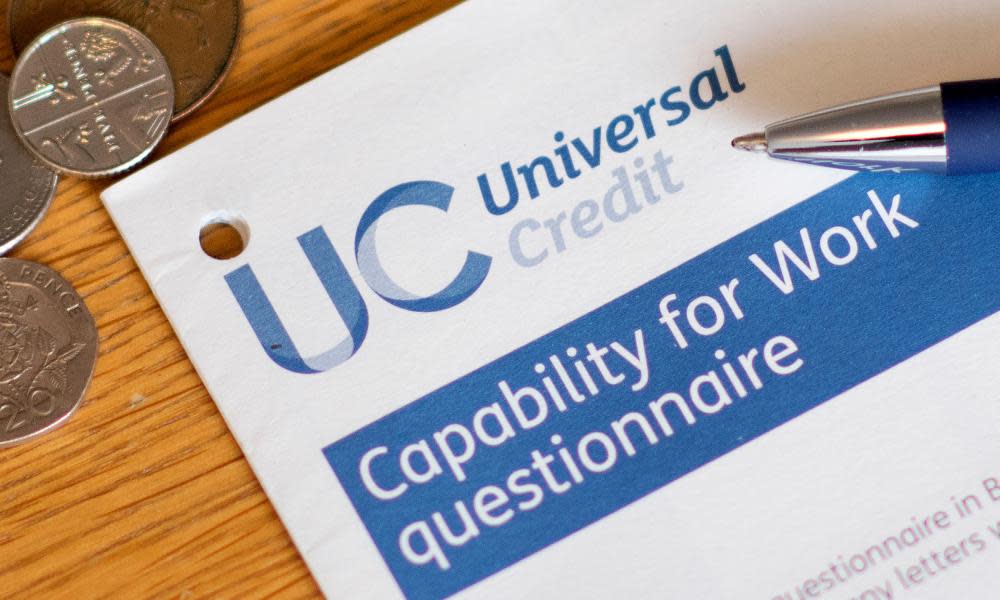What would a real-terms benefits cut mean for UK claimants?

Downing Street has signalled it must cut billions in public spending to pay for its remaining proposed tax cuts. It has so far refused to rule out making savings from the welfare bill. The possibility of a real-terms cut to benefits – by raising them in line with earnings, rather than inflation – has triggered unrest among Conservative backbenchers and anti-poverty campaigners alike.
How much is the benefits bill?
Working-age benefits in Great Britain cost £87.4bn in 2021-22, according to the Department for Work and Pensions (DWP). Of this, universal credit was the biggest chunk – £40.6bn, followed by employment and support allowance (ESA, claimed by sick and disabled people unable to work) with £12.7bn. Disability benefits for working-age people account for about £20bn.
How many people are on benefits?
About 5.5 million people are on universal credit in Great Britain, of which about four in 10 are working. There are approximately 1.7 million people on ESA. About 2.6 million people receive personal independence payment (Pip), the main disability benefit.
What is the process for deciding the rate of benefits?
Benefits are supposedly uprated using the consumer prices index (CPI) rate of inflation as measured the previous September. The DWP carries out a formal review in October. The rate is normally announced in November and comes into effect the following April. On this basis benefits rose by 3.1% in April 2022, reflecting the September 2021 inflation rate, rather than inflation rate at the time, which was nearer 9%. Benefits in Northern Ireland are generally maintained in parity with Great Britain.
So benefit claimants are already enduring a real-terms cut?
Yes. The April 2022 uprating was the biggest fall in the real value of the basic rate of unemployment benefits in 50 years, according to the Joseph Rowntree Foundation (JRF). The government deflected criticism by arguing claimants would “catch up” next year, when the September 2022 rate of CPI inflation (about 10%) would be reflected in April 2023 benefit rises. The former chancellor Rishi Sunak promised in May that this would indeed be the case.
Is benefit uprating automatically tied to the previous September’s prices?
That is the convention but in practice the government has considerable discretion. According to JRF the government has cut the value of working-age benefits in seven out of the last 10 years, including freezing them for four years between 2016 and 2020 even when prices were rising.
How much would benefit claimants lose if benefits were raised in line with September earnings (5.4%) rather than September CPI inflation (10%)?
According to JRF, an increase of 5.4% in April would amount to the biggest permanent real-terms cut to the basic rate of benefits made in a single year. It estimates the poorest 10% of families would lose 2.6% of their income (£214 a year) once personal tax changes are factored in. The richest 10% would gain 4.3%, or more than £5,000.
Government allies are saying it is only fair benefits should rise at the same pace as average earnings, and that a cut will incentivise people to get work.
Critics would argue it is unfair because it is a catch up rather than a rise. Claimants have seen the value of benefits decline massively over recent years and they already pay a “poverty premium” for basic goods and services. There is no robust evidence that cutting their incomes will persuade them to get a job, or a higher-paid job. Bigger barriers are often lack of childcare, poor public transport – and indeed, the lack of better-paid jobs.
What would be the social impacts of real-terms cuts to benefits?
More people on a low income would be pitched into poverty, or deeper poverty. It would suck cash out of local economies – benefits are largely spent in shops and small businesses – at a time when the UK may be in recession, hitting economic growth. The evidence of the last decade – in which austerity policies stripped £37bn from welfare budgets – suggests it would further hit the health and wellbeing of the poorest.
Will Great Britain’s 12.5 million pensioners be affected by a real-terms cut in the value of benefits?
So far the prime minister, Liz Truss, has indicated there will be no real-terms cut in the level of the state pension next April. However, it could be tricky explaining why there should be a cut for low-income working-age people but not pensioners.

 Yahoo Movies
Yahoo Movies 
